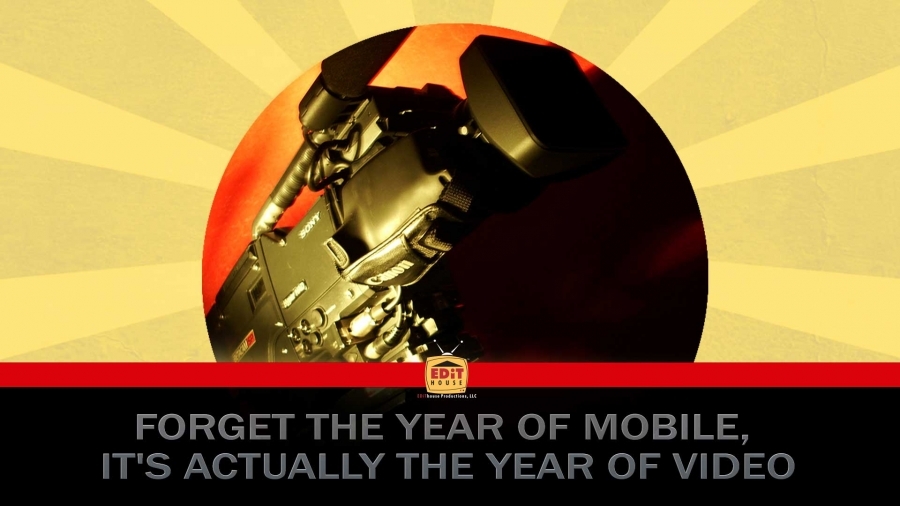As much as we all talked about 2013 finally being the Year of Mobile, we’re convinced that it actually is going to be the Year of Video. Here’s why:
Viewing is growing on video, with more time being spent on more devices. Too much is made of falling network prime-time ratings. According to estimates at GroupM, overall video consumption is up year on year by about 3.7%, assisted by viewing of streaming video on PCs, connected TVs and mobile devices. According to the latest comScore, on average, 183 million Americans view 215 videos each month online. Mobile’s big boost is also being driven by video, with Cisco forecasting that by 2016, two-thirds of mobile traffic will be viewing video.
Dynamic content is growing audiences. The rules are being re-written on the back of strong original programming investment. Cable network AMC’s “Walking Dead’ was the second highest rated show on prime-time television, beating top network shows such as FOX’s “American Idol” and ABC’s “Modern Family” in straight 18-49 ratings. Netflix’s “House of Cards” reportedly pulled in 2.7 million viewers in its first 12 days, which is about the same as what premium cable network Showtime’s pilot of “Homeland” achieved in live and on-demand viewing when it launched in 2011.
Live TV remains a powerful medium. Before you write off network TV, remember that live viewing remains a powerhouse that advertisers still want. Despite 44% home penetration of DVRs, 50% of households now accessing video on demand and 5 million Americans having cut their cable cord, 85% of video viewing is still live television. Live sports, live news and must-see television, such as the season finale of ABC’s “Scandal” or NBC’s “The Voice” are not just good for ratings, but they deliver higher attention to the commercials, and are boosted by more social-media engagement.
Video storytelling continues to be a persuasive brand medium. When it comes to branding, video continues to be a powerful choice for advertisers. Brand-tracker studies and media-mix models consistently prove television to be the most reliable in driving results both in terms of brand recall and sales. TV ads are not just interruptive; they are also engaging. On top of the 100 million viewers that a TV spot in the Super Bowl reaches, ads in the 2012 Super Bowl were viewed 400 million times online. Additionally, there are healthy levels of attention, with online video ads typically achieving a viewed completion rates of 87%.
Video is CPM gold. For publishers, CPMs for video are typically three to four times display CPMs, which is why AOL, Yahoo! and YouTube, but also Vevo and Blip are investing in original video content. So too are the print brands. CondeNast and Wired are venturing into their own video channels. The advertising potential appears promising. Ads are now appearing in 25% of online videos, roughly double the percentage of just two years ago. The increased ad load doesn’t appear to have deterred online video viewership, which continues to rise. On the television side, national broadcast is still able to sustain premium CPMs, while the top cable networks continue to eye those premiums as the potential for upside.
The media are changing the game on video. But are we evolving to meet those opportunities?
Video content is being consumed in multiple contexts and devices, from live-event television to catch-up viewing on demand, niche viewing on mobile, binge viewing via Hulu or user-generated video. Are we thinking strategically about the types of ad forms we are placing in those different environments that best optimize the brand experience?
According to Bright Roll, Inc., only 10 to 15% of online video ads are interactive. The rest run variations of ordinary TV spots. Are we underutilizing the opportunity to be more immersive?
Some level of addressable television, either by individual household or zip code, in 60 million homes is increasing opportunities to make television advertising more relevant. Are we drilling and responding enough to user data?
With so many alternatives, delivering a more effective video strategy needs multiple content solutions. Are we developing and deploying more cost-efficient ways to produce advertising video content?
The future for video is bright, as it is for the brands and agencies that choose to exploit the full capabilities of video.
Story credit: http://adage.com/article/digitalnext/forget-year-mobile-year-video/241462/

Matt, quite literally, grew up around television production, and started setting up lights and equipment at just 9 years old. Matt began officially working for Edit House Productions, LLC at a young age and officially joined the team at 15 years old. Matt graduated from Rio Rancho High School in 2010 and attended CNM, taking psychology courses and focusing on general studies and today, he is a multiple Telly Award winning editor. Matt has extensive knowledge of Adobe Premier Pro, After Effects along with the entire suite of Adobe Creative Cloud applications including Adobe Photoshop, Illustrator, InDesign, and Audition. Matt is well-versed in producing, directing, and cinematography.
In 2020, Matt became a Co-Owner of Edit House Productions and Ad House Advertising. In 2022, Matt became the Chief Operating Officer as well. As COO, Matt is responsible for the daily operations of the company. Matt also serves as Studio Manager for Edit House Productions 2000 square-foot studio space
Matt is a huge Stranger Things fan and was ecstatic when Edit House Productions was able to work with Finn Wolfhard on a production in 2021.
Matt married to his high-school sweetheart, Kaitlin in 2013. They enjoy spending time with their daughters, dogs Oliver and Izzy, cooking, cigars, family, and music.

